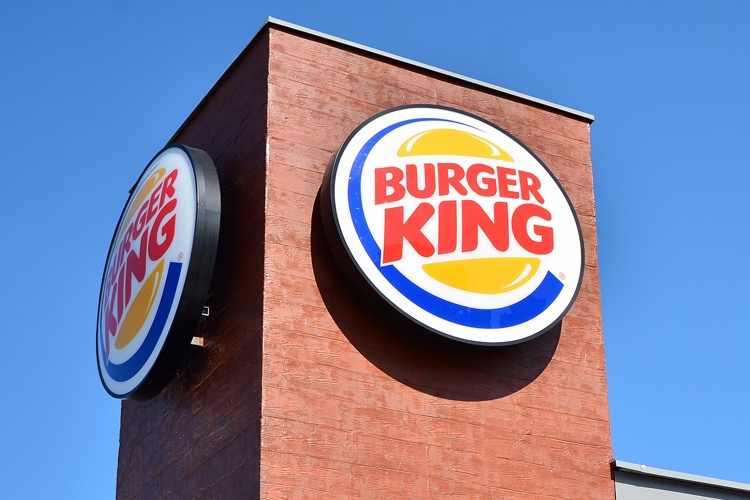Burger King has long battled its chief rival McDonald’s for world burger dominance. Now in the second spot behind the Golden Arches, the chain has more than 12,000 restaurants in 73 countries. The company is known for its bright, retro-styled logos and its infamous Burger King mascot.

Early Inspiration
In 1953, Keith Cramer and his stepfather Mattew Burns visited the McDonald brothers’ burger store in San Bernardino, California. This was the same store that had inspired McDonald’s founder Ray Kroc. Cramer and Burns wanted to create something similar, and they bought the rights to an instant grilling machine called the Insta-Broiler.
Their first restaurant opened in Jacksonville, Florida. They named it Insta-Burger King. They quickly began franchising Insta-Burger Kings to other locations.
Fast and Flame-Broiled
In 1959, Kramer and Burns were bought out by two franchisees in Miami, James McLamore and David Edgerton.
McLamore and Edgerton changed the name to Burger King. They also invented a new device that could flame broil burgers in minutes. It produced better burgers than the earlier Insta machine.
The quick flame broiler made Burger King stand out from its competitors. In 1955, McLamore created a burger he named the Whopper. The name let hungry customers know they were getting a huge burger, and the rest is burger history.
First Logos
The restaurant sold “insta-burgers” and “insta-shakes,” and it promised both could be ready in 15 seconds. The owners eventually expanded into more than 250 locations. In 1967, they sold Burger King to the Pillsbury Company.
Kramer and Burns created the company’s first logo. It was a simple, bold design that said “Burger King” under a half-setting sun. McLamore and Edgerton later changed the logo to just the company name in a custom typeface.
The King Appears
The Burger King mascot first showed up on the sign at a Burger King location in Miami. He was a jolly, smiling king sitting on a hamburger throne and holding a soft drink. He appeared on the official company logo in 1957.
The 1960s were a banner decade for logo redesigns. Many companies overhauled their designs during this time. In 1969, Burger King joined the trend with a logo that resembled a stylized hamburger bun with the name Burger King in bold red letters inside the bun.
Retro Design
This design remained largely the same until the 1990s. In 1999, Burger King introduced a new logo that looked less like a hamburger and more like a button or badge. The round logo features a bright blue line circling a bun top with the name Burger King in red.
In 2021, Burger King announced it had introduced a new logo. The logo looks remarkably like the 1969 “bun” logo. It features a stylized, golden hamburger bun with the name Burger King in red lettering inside the bun. It has not yet appeared on any packaging or advertising.
A Cartoon King
In the 1960s, Burger King first began using animated versions of their King mascot named Kurber Bing. Kurber Bing appealed to children, and the ads featured him in various child-friendly storylines.
Later, the King took on a more kingly look. He appeared wearing a crown and long robes. The ads called him the “Marvelous Magical Burger King.” They featured the king handing out prizes and food to children with the tagline, “Burger King, where kids are king.”
“Creepy” King
In 2003, Burger King’s advertising went to the Crispin Porter & Bogusky agency. While searching for ideas, a Crispin Porter employee found an old 1970s Burger King head for sale on eBay. The giant head had been created to spark brainstorming ideas at Burger King corporate meetings. It was not meant to be seen by the public.
The agency revived the Burger King figure using the giant, rediscovered head. Their design team created a caricatured version of the head and a new character they named “the King.”
In a series of edgy advertisements, the King would show up unexpectedly when people were showering, sleeping or on their way to a work meeting. He wore the King mask and royal robes. The King never spoke and never took off his King mask. In these ads, the King would silently offer a Burger King food item.
Retiring the King
The ads drew mixed reactions. Some people thought they were hilarious, but others found them unsettling. The ads accompanied a slump in sales for the burger giant. In 2011, Burger King officials pulled the campaign, saying the creepy figure scared women and children.
The “Creepy King” has made occasional reappearances since then, and he has appeared as a character on animated TV shows and video games. The company has no plans to bring him back as a full-time mascot, however.
Trademark Lawsuits
One of the most interesting Burger King trademark lawsuits involved a restaurant in Mattoon, Illinois.
Gene and Betty Hoots purchased the restaurant in 1954 and named it Burger King. This was years before there was a Burger King chain in the area. They also owned the Frigid Queen, an ice cream shop right next door.
Avoid an issue like the original Burger King had – trademark your logo today.
The Original Burger King
The Mattoon restaurant has been a popular local destination ever since. When the Hoots learned about the fast food franchise with the same name, they acted quickly. In 1968, they sued to prevent the Burger King chain from opening any restaurants in their area.
Since they had already trademarked the name, the Hoots prevailed. A judge ruled that no other restaurant named Burger King could open within 20 miles of their establishment. The decision is considered a landmark in federal trademark law.
Still King of the Whoppers
Burger King continues to innovate with the introduction of breakfast items, the vegetarian Impossible Burger and other items that set it apart from its burger competitors. If the company can avoid creeping out the public, it should continue to be successful.

